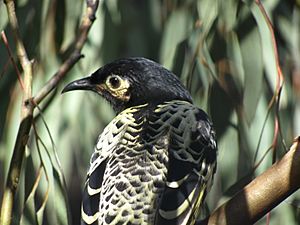Regent honeyeater facts for kids
Quick facts for kids Regent honeyeater |
|
|---|---|
 |
|
| Conservation status | |
| Scientific classification | |
| Genus: |
Anthochaera
|
| Species: |
phrygia
|
 |
|
| Distribution of the regent honeyeater, see file for more details. | |
| Synonyms | |
|
|
The regent honeyeater (Anthochaera phrygia) is a beautiful bird found only in southeastern Australia. It is a critically endangered bird, meaning it is at very high risk of disappearing forever. People often call it a flagship species. This means that efforts to save the regent honeyeater also help protect many other animals and plants that live in the same areas. Scientists have learned that this bird is closely related to the wattlebirds.
Contents
About the Regent Honeyeater
The regent honeyeater is a striking bird with unique colors. Its neck and head are a shiny black. Its chest has bright yellow spots that stand out. The feathers on its tail and wings are a mix of black and bright yellow.
What Do Regent Honeyeaters Eat?
Regent honeyeaters mostly drink nectar from eucalyptus trees and mistletoe plants. Nectar is a sweet liquid found in flowers. They also eat some insects and a sweet substance called honeydew, which comes from insects. Sometimes, they will eat native fruits and even fruits from gardens.
Reproduction and Life Cycle
Regent honeyeaters usually breed from August to January. This is during the spring and summer in Australia. Their breeding season seems to match when eucalyptus and mistletoe flowers are blooming.
Female regent honeyeaters lay two or three eggs in a cup-shaped nest. Sadly, many nests do not succeed, and many young birds do not survive. Other birds and tree-dwelling animals often eat the eggs or young birds. Also, there are more male regent honeyeaters than females, which can make breeding harder.
Where Do Regent Honeyeaters Live?
The regent honeyeater used to be common in wooded areas of eastern Australia. They were especially found along the inland slopes of the Great Dividing Range. They once lived as far west as Adelaide. However, they are now gone from South Australia and western Victoria.
As of June 2020, their range stretches from north-east Victoria up to the Sunshine Coast, Queensland. But their population is now spread out in small groups. Most sightings are in a few places: north-eastern Victoria, the western slopes of the Great Dividing Range in New South Wales, and the central coast of New South Wales. In 1999, their three main breeding areas were the Bundarra-Barraba area and Capertee Valley in New South Wales, and north-eastern Victoria.
Many of these breeding sites were badly affected by the huge 2019-2020 Australian bushfires. These fires likely had a very negative impact on the already small wild population.
Important Bird Areas
BirdLife International is an organization that identifies places important for birds. In 2011, they listed these sites as important for regent honeyeaters:
- Queensland
- Traprock
- New South Wales
- Brisbane Water
- Bundarra-Barraba
- Capertee Valley
- Greater Blue Mountains
- Hastings-Macleay
- Hunter Valley
- Lake Macquarie
- Mudgee-Wollar
- Richmond Woodlands
- Tuggerah
- Victoria
- Warby-Chiltern Box-Ironbark Region
In 2018, some birds were seen in south-eastern Queensland. This was unusual and suggested that a drought in northern New South Wales was forcing the birds to look for food elsewhere.
Protecting the Regent Honeyeater
The regent honeyeater is listed as critically endangered on the IUCN Red List. This is a global list of threatened species. It is also listed as endangered under Australia's Environment Protection and Biodiversity Conservation Act 1999 and Queensland's Nature Conservation Act 1992. In 2011, the Action Plan for Australian Birds 2010 also added the regent honeyeater to the "critically endangered" list. The main reason for this is the loss of their natural habitat.
The bird's status was changed from Endangered to Critically Endangered in Australia on July 9, 2015. Each state in Australia has its own rules for protecting the bird. For example, Victoria lists it as "threatened," while New South Wales lists it as "critically endangered."
The Australian government created a plan in April 2016 to help the regent honeyeater recover. The 2019-2020 bushfires likely pushed the species even closer to extinction. At that time, there were only about 250 of these birds left in the wild.
Conservation Efforts
People are working hard to save the regent honeyeater. A special program raises birds in captivity. In June 2020, 20 birds (11 female and 9 male) were released into the wild in the Hunter Valley. In 2012, birds from a Taronga Zoo breeding program were also released in the same area.
A lot of effort goes into making sure the released birds have enough food. Most of the birds wear tiny radio transmitters. These devices help scientists track their movements. There were about 13 wild birds at the release site. It was hoped that the captive-bred birds would breed with the wild ones. This would help increase the population and make it more diverse. This was the first time regent honeyeaters had been released since a similar event in north-eastern Victoria.
In August 2020, one of the banded birds was seen and photographed at a home in the Hunter Valley. This was two months after her release. Another bird was found and led conservationists to a new group of wild regent honeyeaters near Broke. This group was about 30 kilometers from the release site, and scientists had not known about them before. This shows how important these efforts are!
See also
 In Spanish: Mielero regente para niños
In Spanish: Mielero regente para niños



